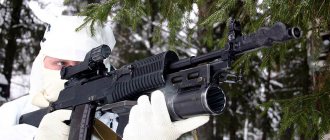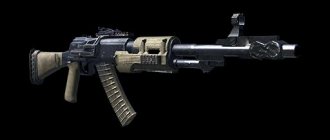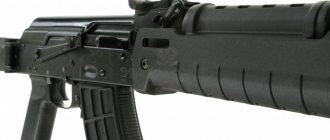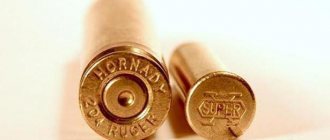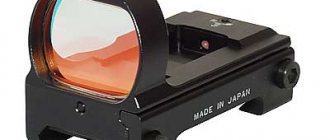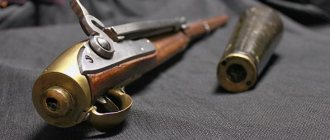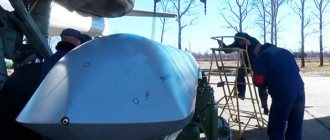Automatic AN-94 "Abakan", a weapon developed by order of the USSR Ministry of Defense. The main feature is the rollback of the barrel with the bolt when firing, which allows the bolt to not move forward through the magazine. As planned, it was supposed to replace the AK in the army of the Soviet Union. The name “Abakan machine gun” was given after the competition of the same name, which he won.
AN 94 was developed for all branches of the Russian army and was intended for widespread rearmament of the army, but this did not happen, perhaps due to economic difficulties, perhaps due to design difficulties. Difficult to maintain, it could not replace the AK for new recruits. The main application for the accuracy and accuracy of the Abakan is considered to be the destruction of single targets during defense or special operations. Therefore, AN-94 ended up only in some army units and special forces units of the Ministry of Internal Affairs. Foreign intelligence agencies also became interested in him in order to unravel the secret of the pulse displacement system.
| Caliber | 5,45 |
| Weight | 3.85 kg. |
| total length | 93 cm. |
| Barrel length | 40 cm. |
| Rate of fire | 600 – 1800 rpm |
| Sighting range of fire | 700 – 800 meters |
| Store type | 30 round box |
| Manufacturer country | USSR, Russian Federation |
The AN-94 "Abakan" was first publicly presented at a weapons exhibition in the city of Nizhny Novgorod in May 1993, designed by Gennady Nikonov, formerly known as the ASM. This is a new generation carbine that significantly surpasses its analogues in tactical technical characteristics. It has no analogues in many technical solutions. The production of the sample remained secret. Its system is significantly different from the AK. Another interesting feature is that the Abakan is seen as a Russian version of the American Objectie Individual Combat Weapon (OICW), as it is truly different from previously developed Soviet/Russian weapons.
AN-94 assault rifle "Abakan"
In the AN-94 sample, the magazine is located at the front according to the classical layout, the magazine is box-type, 30 rounds. The cartridges are arranged in two rows in a checkerboard pattern, the fuse is located on the left. The firing device is located in a casing and is movably fixed, consisting of: a bolt, a hammer and a bolt frame, to which the trigger mechanism is attached from below. Automatic firing is ensured thanks to the free rollback of the firing unit, equipped with a gas engine drive from the bolt frame.
The carbine has a number of features. It is made according to a fire monitor design. The recoil reduction system is borrowed from the designs of artillery guns, based on the recoil of the barrel with the bolt. By shifting the recoil impulse, the accuracy and accuracy of fire is improved. Under the influence of recoil, the firing unit moves backward during the first shot and cocks the hammer, which is located in the rear part of the receiver; during the displacement, a second cartridge is sent from the intermediate chamber and the second shot is fired. By this time, the third cartridge has already been sent into the barrel and all that remains is to pull the trigger to continue firing. Recoil is felt only when the shutter is in the rearmost position, by which time two shots have already been fired.
As a result, the rate of fire increases to 1800 rounds per minute; with automatic firing using the one shot per cycle method, the rate of fire is 600 rounds.
Folding stock, plastic. Steel case with shockproof plastic. The bayonet is attached to the right and has the ability to install an under-barrel grenade launcher. The standard sight is diopter, you can place a night sight and an optical one. Unlike Kalashnikov weapons, it is equipped with equipment with three firing methods: single, fixed volleys and continuous fire. Mode switching is performed by a translator located on the left above the trigger guard. On the right side of the bolt frame is the charging handle.
Automatic machines of Russia
AN 94 assault rifle with folded buttstock
In modern conditions, according to military experts, the nature of close fire combat has changed noticeably and an important condition for achieving victory is the ability to defeat the enemy with a short and accurate burst. In addition, this saves ammunition and allows you to fight for a longer time without being distracted by replenishing ammunition.
In 1978, the GRAU formulated a requirement to increase the efficiency of firing from a machine gun by 1.5-2 times compared to the AK 74. In August 1981, the Commission on Military-Industrial Issues under the Council of Ministers of the USSR approved development work on the topic “Abakan” . Increased shooting efficiency was to be achieved by increasing accuracy when shooting from unstable positions (on the move, standing, kneeling, without a rest).
Initially, 10 design groups from Tula, Izhevsk, Kovrov, Klimovsk presented 12 projects. Prototypes were tested at the end of 1984. Their designs differed, but in principle three automation schemes competed: - “classical” with a gas engine - automatic machines TKB-0111 by G. A. Korobova, TKB-0136 by N. M. Afanasyev (both - from TsKIB SOO), APT I. A. Postnikov (“Izhmash”); — with a displaced recoil impulse — TKB-0146 I. Ya. Stechkina (TsKIB SOO), AS G. N. Nikonova (“Izhmash”); — balanced — AEK-971 by B. A. Garev, AEK-978 by P. A. Pikinsky (both from SKB Kovrov Mechanical Plant), AKB by V. M. Kalashnikov (“Izhmash”).
The Stechkin, Korobov and Nikonov assault rifles successfully passed field tests. The main competitors were the Stechkin and Nikonov samples “with a displaced recoil impulse” (meaning a shift in the action of the recoil impulse in time relative to the moment the bullet leaves the barrel). In 1985, a modified machine gun by G.N. Nikonov appeared under the designation ASM. In 1989, the ASM was recommended for military tests, which took place in 1991. Finally, in 1997, the “5.45-mm Nikonov assault rifle mod. 1994, AN 94" chambered for a standard 5.45 mm cartridge and with a standard magazine.
The AN 94 assault rifle (index 6PZZ) uses a gas automatic engine and a locking unit with a rotating bolt, but the operation of the systems is original.
The barrel with a gas chamber and a gas tube is connected to the receiver, inside which a bolt frame with a rotary bolt moves longitudinally. This assembly constitutes a firing unit installed inside the casing-carriage and, when firing, moving back and forth in it (the so-called “carriage” installation diagram). Inside the receiver behind the bolt frame there is a return spring for the bolt group and an additional shock absorber that accelerates the roll of the bolt group. The reloading handle is located on the right. On the left in the casing under the movable receiver there is a return spring.
When firing with a fixed burst, the firing unit comes to the rearmost position after two shots fired at a high rate (1800 rounds/min), and the bullets manage to leave the barrel before the machine gun has yet moved under the influence of recoil. The shooter perceives the recoil impulse already at the end of the burst (hence another name - “system with accumulation of recoil impulse”). The cartridges are fed from a standard box magazine with a capacity of 30 rounds. The magazine is attached to the machine gun with a deflection to the right - due to the placement of the receiver return spring in the casing - and remains motionless when firing. This required the introduction of a two-stage cartridge feeding scheme with an intermediate chamber and an additional rammer connected to the bolt frame using a steel cable passing through a large pulley located on the left of the receiver. When the bolt frame moves backward, the cable pulls the rammer forward, which pushes the upper cartridge out of the magazine and feeds it into the intermediate chamber. When the bolt frame moves forward, the bolt picks up the cartridge from the intermediate chamber and sends it into the chamber of the barrel, and the rammer returns back. The push-pull cartridge feeding circuit, in addition, prevents damage to it at a high rate of fire.
When the bolt frame moves backward, the hammer, located in the rear of the receiver and connected to the trigger by a system of rods and levers, is cocked. After the second shot, the hammer is locked in the cocked position, the firing unit returns forward, and the next cartridge is already in the chamber of the barrel. To continue firing, you must release and press the trigger again.
Automatic AN 94 incomplete disassembly: 1 - cover assembly; 2 — feeder (ejector) with a cable; 3 - roller; 4 — ejector spring; 5 — firing unit (barrel with receiver, bolt frame, bolt, impact mechanism); 6 — muzzle brake; 7 — casing with butt; 8 - store; 9 — trigger mechanism with pistol grip; 10 - ramrod and ramrod base
Single-shot and automatic fire with a normal rate of fire (600 rounds/min) is also possible. With such automatic fire, the first two shots are fired at a high tempo, the hammer is held in the cocked position until the firing unit is completely returned to the forward position, the self-timer releases the hammer, and the third shot occurs. After this, the self-timer is triggered only once during the full cycle of movement of the firing unit,” thereby the machine automatically “switches” to a normal, low rate of fire. The “carriage” installation, the stroke length of the firing unit and the presence of a shock absorber eliminate the sharp impact of the moving parts on the casing at the rear point, thereby increasing the stability of the weapon. That is, an improvement in accuracy also occurs with automatic fire without cutting off the burst length.
The trigger mechanism and pistol grip are made as a separate assembly. A two-position push-button non-automatic safety with a wide key is mounted within the trigger guard - on the left in front of the trigger (in the “P” position it blocks the sear and trigger), the fire mode translator is on the left above the trigger. The translator has three positions - “OD” (single shots), (fixed burst) and “AB” (automatic fire).
The sighting device includes a front sight with a safety lock on a stand in the muzzle of the barrel and a diopter sight in the rear part of the casing. The sight has five shields with apertures with corresponding markings.
Automation “with a shifted impulse”, a large length of the aiming line, a diopter sight, a muzzle brake - a flash suppressor are intended to increase the likelihood of hitting a target from the first burst. On the left side of the casing there is a strip for attaching an optical, collimator or night sight.
The right-folding buttstock is made of impact-resistant plastic, as are the casing with the fore-end and the pistol grip. The plastic casing made handling the machine more comfortable.
The AN 94 was initially supposed to be combined with existing devices for machine guns - a bayonet, under-barrel grenade launchers, sights, installations for firing from VML, armored personnel carriers and helicopters. The problem of the AKM and AK 74 - the simultaneous attachment of a bayonet and a grenade launcher - was solved simply: the bayonet is attached horizontally to the right. Of course, Nikonov is more complicated than Kalashnikov, but this is inevitable when moving to a new generation of weapons. The complication did not affect the reliability of operation in combat conditions.
The assault rifle was planned to replace the AK 74, AKS 74, AKM and AKMS. But for a number of reasons, including the difficult economic problems of the 1990s and the need for more thorough training of soldiers to handle weapons, the number of AN 94 in the troops remained very small. Production of AN 94 at Izhmash was carried out in small batches. Further development of the system was significantly hampered by the sudden death of its creator, G.N. Nikonova. In the end, taking into account the complexity of the machine gun system and its higher cost, the AN 94 was left only for arming special units of the army and the Ministry of Internal Affairs, staffed by professionals.
Automatic AN 94, barrel stroke
Tactical and technical characteristics of the AN-94 assault rifle
Caliber: 5.45 mm Cartridge: 5.45x39 (model 1974) Weight of weapon with magazine without cartridges: 4.1 kg Length of weapon without knife bayonet: with folded butt: 943 mm with folded butt: 728 mm Barrel length: 405 mm Muzzle velocity: 900 m/s Rate of fire: 1800 / 600 rds/min Sighting range: 700 m Magazine capacity: 30 rounds
History of creation
AN-94 was created by Nikonov Gennady Nikolaevich, graduated from the Izhevsk Mechanical Institute, worked at the Izhmash Production Association. For the needs of the USSR Ministry of Defense, a weapon with a high rate of fire, accuracy and accuracy of fire from awkward positions was needed, superior to the AK-74. A competition was announced in 1978 for the development and creation of this prototype. After studying, it became clear that a circuit with a recoil impulse displacement is best suited. In 1981, a new competition was announced, called “Abakan”. The main competitors in the fight were Stechkin and Nikonov assault rifles. As a result, the winner was the model created by Gennady Nikonov, which was given the name AS or automatic machine with a displaced recoil impulse. In total, twelve prototypes of different models from different design bureaus took part in the competition.
Through the systematic development of a number of prototypes, Nikonov was able to improve the sample to approximately the desired characteristics, which received the new name ASM or automatic machine with a shifted recoil impulse, modernized. A special feature of the AN was a new system, the main principle of which was the movement of the receiver inside the casing when firing, thereby achieving the maximum possible simplification of the design, which increased the combat capabilities of the ASM over its competitors. A scheme for chambering the cartridge into the barrel while moving the box during shooting was also used.
Despite the comparative complexity of weapon design compared to other types of systems, the AS surpassed many models in combat effectiveness. The machine can be disassembled for cleaning into 13 components when not fully assembled, which include coil springs, a roller and a cable. AN-94 is a representative of weapon systems with accumulated recoil impulse.
Automation is based on the principle of gas removal when fired from the barrel, together with the rollback of the firing unit. The very basis of the principle of a displaced recoil impulse was the design scheme for the recoil of artillery guns. Thus, a supporting lever was attached to the firing unit, located below the barrel and ensuring its stability during rollback. It looks like a gas tube. The firing unit is a barrel mounted in the receiver, moving along metal guides inside the monitor casing.
A plastic cover with a jumper closes the casing. The receiver contains the trigger and bolt carrier. When a shot is fired, a reciprocating movement occurs inside the casing, namely, the receiver with the barrel moves back, which gives rise to the movement of the bolt group. At the same time, in the outer casing, the movement of the firing unit also begins. The difference between this type of weapon is that at the moment the bolt moves, it does not need to go through the magazine to pick up the cartridge, which cannot be said about the usual type of small arms. The cartridge enters the barrel in two stages, due to the AFM feeding system. When the bolt frame is displaced, the cartridge is sent into the chamber, which was previously removed from the magazine. The stroke size is slightly larger than the length of the cartridge. In this way, charging occurs faster; the presence of a shock absorber and buffer in the sample reduces recoil and speeds up the return of the firing unit back.
This design provides an increased rate of fire. The trigger mechanism is a separate design and supports three fire modes: automatic - firing at a low rate, bursts, fixed firing of two rounds, single. The mode selector is located above the handle, the fuse is on the body. With fixed firing, the rate of fire is approximately 1800 rounds per minute, with continuous automatic fire approximately 600.
Subsequently, it was repeatedly refined and tested, as a result, in 1991 the ASM was ready for adoption, but this did not happen (most likely due to the collapse of the USSR) and only in 1997 the ASM was approved and adopted by the Russian army, The assault rifle was named AN-94 or Nikonov assault rifle, but the expected full-scale transition from the AKM did not happen. Abakan is produced in small batches at Izhmash.
Application
The AN-94 was tested in the Taman Guards Division, in the Moscow Military District. The results were stunning and fully satisfied the requirements of the Ministry of Defense, the most significant achievement was the accuracy of firing when firing in a fixed mode from awkward positions, the accuracy of hits, as well as the accuracy when conducting automatic continuous fire, up to 13.5 times more effective, and the lethal force exceeded twice competitors. Based on the results, it was approved for adoption, but financial difficulties caused by the collapse of the USSR pushed back the delivery time to the army indefinitely.
In 1993, at the world-famous arms exhibition in Nizhny Novgorod, the AN was exhibited, where its capabilities were appreciated. By order of the Ministry of Defense of the Russian Federation, repeated tests of the ASM were carried out in 1994, as a result of which it was adopted by the Russian Army in 1997, but was never widely used. In 1988, IZHMASH received a limited order for the production of AN-94. Foreign intelligence services and companies, however, showed interest in him. even having received a Euro patent. The weapon never made it into production and is used only in special units. Such distribution can hardly be called large-scale use. Nikonov complained about this, saying that it would not be easy at all to introduce the easiest-to-use, most reliable, widespread assault rifle in the world, such as the AKM, into the army. To do this, you will need to present a sample significantly superior in characteristics to all analogues. The model reached this level of excellence, economic difficulties, difficulty in production and difficulties in disassembling and maintaining took their toll. Manufacturing the AN-94 costs more than the AKM. Therefore, the prospects, alas, are not cheerful and it seems that the use of this weapon will be limited only to special forces of the army and detachments of the Ministry of Internal Affairs, where its high combat capabilities will be appreciated.
Prospects
SVD (top) and AN-94 Abakan at the celebration of the 70th anniversary of the victory in the Battle of Stalingrad at TsNIITOCHMASH
The future prospects of the machine are not entirely clear. On the one hand, it has some clear advantages over both the AK modifications currently in service and other prototypes, and is also superior to many small arms in service with other states. On the other hand, the complexity of the design (and, accordingly, the length of training of shooters) prevents the use of the AN-94 to arm conscripts. In addition, the advantages of the AN-94 manifest themselves mainly not in assault combat, but in the defense of fortified points and special operations (where it is not the high density of relatively concentrated fire that is more important, but the reliable destruction of single targets).
In addition, there are alternative designs that can be used with greater success for the massive rearmament of the army. A possible competitor to the AN-94 in this area is the AEK-971, an assault rifle with balanced automatics. The AEK-971 has slightly worse accuracy in a short burst than the Abakan, but when firing in long bursts it is superior to both the AK74 and the Abakan, and at the same time it is structurally simpler, cheaper, and lighter than the AN-94. There are also modifications of the AK-107 and AK-108, which have balanced automation similar to the AEK.
In September 2013, state tests of new assault rifles from various domestic manufacturers were announced for the “Ratnik” combat equipment set with the aim of replacing the . Preference among the candidates was given to the A-545 assault rifle from the Degtyarev plant, created on the basis of the AEK-971. AN-94 was not mentioned among the candidates.
Disassembly and assembly of AN-94 "Abakan"
1. The magazine is released by pressing the latch with your thumb. 2. Remove the safety lock. Check whether the weapon is unloaded; to do this, you need to retract the bolt frame twice. 3. Remove optical devices for aiming, if any. The sight is moved back when turning the handle of the clamping lever 4. Remove the pencil case with tools from the butt. Remove the lapping brush from the pencil case. A screwdriver and a drift. 5. Place the machine in the folded position. Take out cleaning rod 6. Next, you need to open the casing cover. 7. Place the fire mode selector in the position for automatic fire. Remove the firing unit and set the safety to the neutral position “O” 8. Remove the mainspring and remove the buffer mechanism. 9. Then, you need to remove the trigger from the receiver. 10. Remove the frame with the bolt from the receiver. 11. Afterwards, you need to get the ejector with the cable. 12. Separate the muzzle brake from the firing unit 13. Separate the trigger mechanism from the casing
Assembly order
1. First of all, attach the trigger mechanism to the housing. 2. For further assembly, it is necessary to connect the firing unit with the muzzle brake. 3. Then, you need to return the ejector with the cable back to the receiver. 4. The next action should be to return the frame with the bolt to the receiver. 5. Insert the cable into the hole with the groove in the bolt frame. 6. Afterwards, insert the trigger into the bolt frame. 7. Next, attach the spring and buffer mechanism. 8. Place the roller on the body. 9. Return the firing unit to the casing.
Currently, the AN-94 is one of the best examples of automatic small arms in the world, which is supported by the fact that it was used not only during testing, but was also used in real combat, confirming its advantages (high rate of fire, accuracy and accuracy of cartridges).
Unfortunately, the designer of the AN-94, Gennady Nikolaevich Nikonov, died in 2003, but his ideas are alive.
5.45 automatic Russia USSR
About interesting facts
Nikonov's AN-94 assault rifle aroused the interest of foreign intelligence services. This contributed to the fact that foreign, including American, gunsmiths developed modern automatic weapons. The main reason for this is the use of the latest operating principle in the AN-94. This consists of a time-shifted recoil impulse. According to the designer himself, this weapon can be disassembled and copied, but this principle will not be solved for many years. There is also an “Abakan” airsoft machine gun. It is used when training military personnel in simulated combat conditions.
